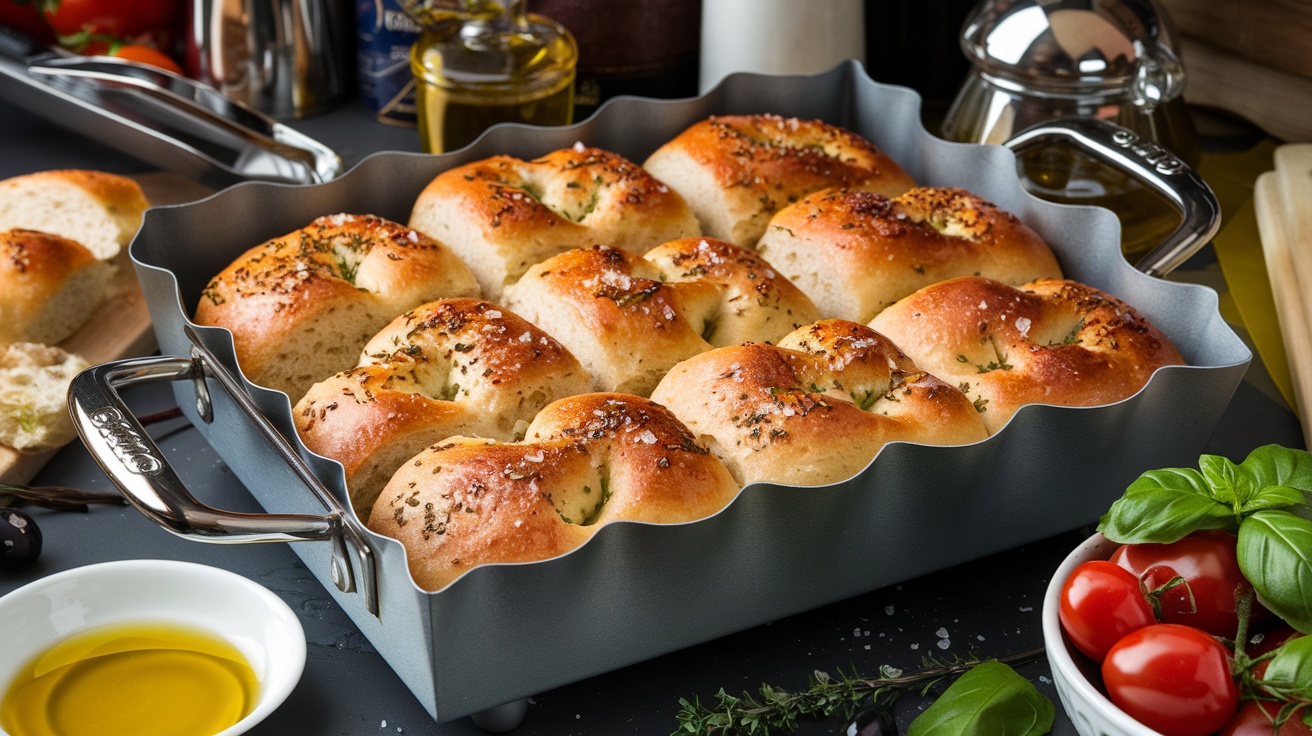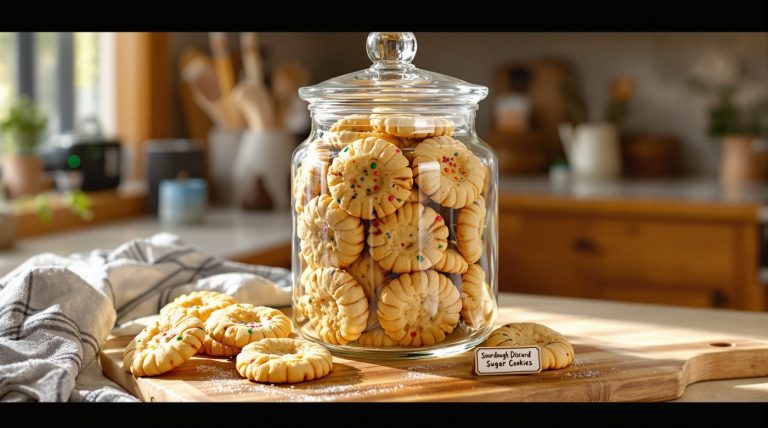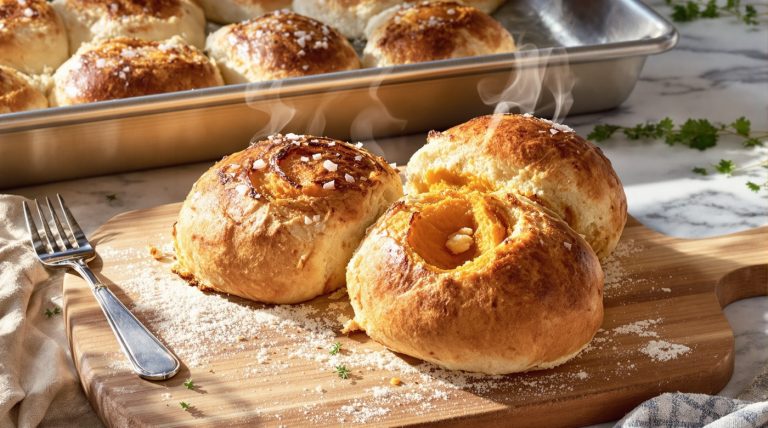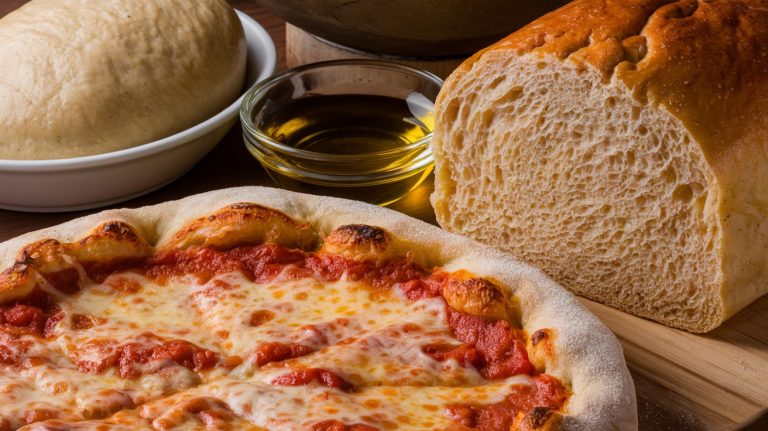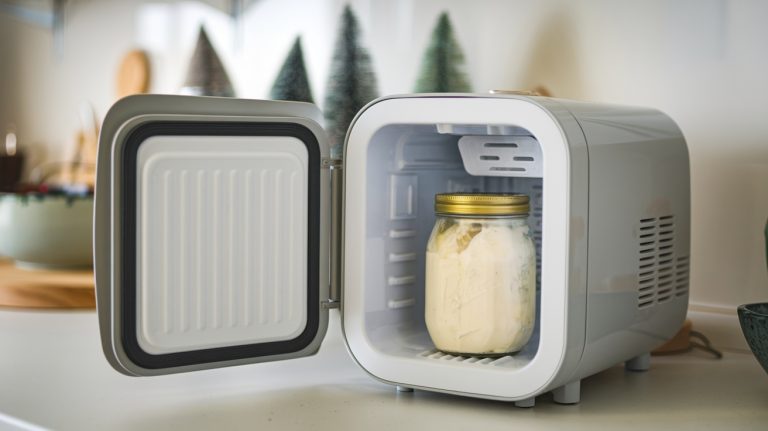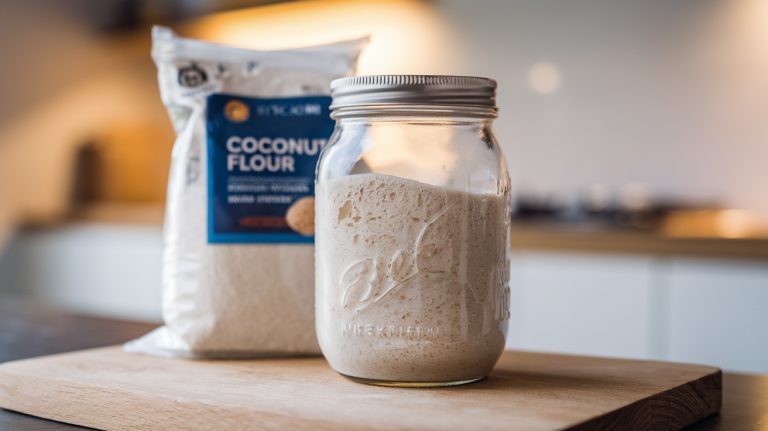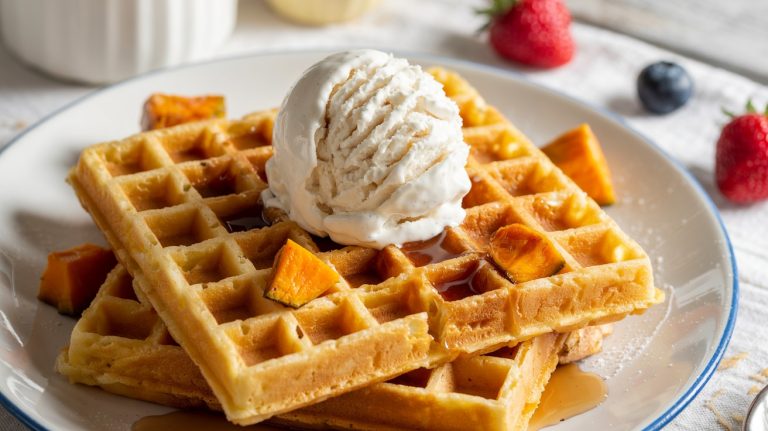How to Make Focaccia With Overproofed Sourdough?
You can turn your overproofed sourdough into a delectable focaccia that’s full of flavor and texture. Start by generously coating a baking pan with extra virgin olive oil. Transfer the overproofed dough and let it rest for an additional 1.5 to 2 hours until airy.
Create deep dimples in the dough and drizzle with more olive oil, then sprinkle on coarse sea salt and fresh herbs. Preheat your oven to 425°F and bake for 25-30 minutes until golden brown.
The result will be a crispy exterior and fluffy interior—perfect for experimenting with toppings. There’s more to explore about enhancing your focaccia.
Key Takeaways
- Use overproofed sourdough as the airy base, ensuring it shows signs like a shiny, bubbly surface and a collapsed feel when poked.
- Generously coat the baking pan with extra virgin olive oil to prevent sticking and enhance flavor.
- Create deep dimples in the dough to help retain moisture and allow toppings to adhere effectively.
- Preheat the oven to 425°F (220°C) and bake for 25-30 minutes until golden brown and crispy.
- Experiment with toppings like fresh herbs, coarse sea salt, and optional ingredients like olives or cheeses for enhanced flavor.
Overproofed Dough
When baking sourdough, you must monitor the fermentation process, or you might end up with overproofed dough. Overproofing occurs when your dough ferments for too long, causing it to rise excessively and lose its structural integrity.
You’ll know you’re in trouble when your dough has doubled or tripled in size, sports a shiny, overly bubbly surface, and feels collapsed when you gently poke it. It’s crucial to highlight that the ideal fridge temperature for sourdough starter is between 38-40°F (3-4°C), which helps maintain its dormancy and prevents overproofing while in cold storage, allowing optimal longevity.
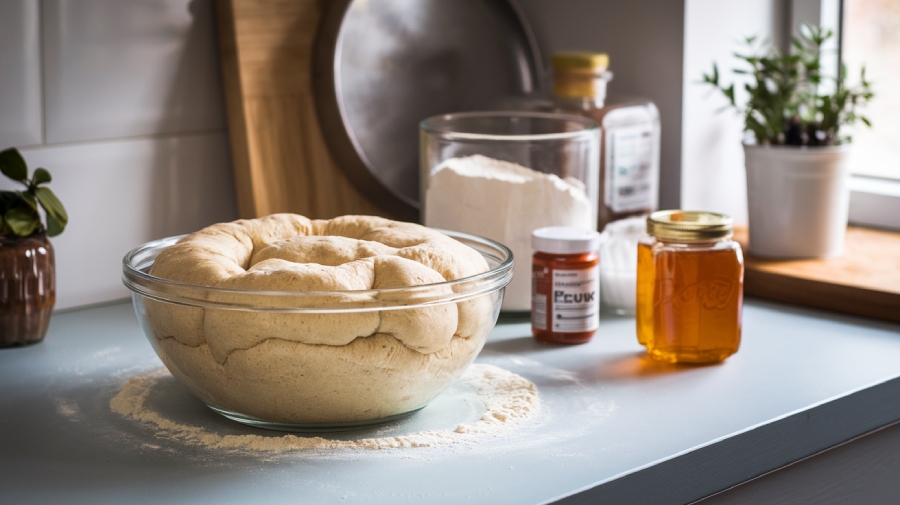
These signs of overproofing can lead to a dense final product with an unpleasant sour flavor profile due to prolonged fermentation. If you catch it in time, you can still salvage that overproofed sourdough by repurposing it into focaccia. This type of bread features a more forgiving dough structure, allowing you to get creative with toppings.
To avoid this situation, monitor your fermentation times closely, especially since ambient temperature and dough hydration levels can considerably impact how your dough ferments.
Ingredients for Focaccia
What makes the perfect focaccia? It all starts with high-quality ingredients that elevate your overproofed sourdough into something extraordinary.
Here’s a breakdown of the essentials:
- Overproofed Sourdough: This is your base. It’s light and airy, providing the perfect texture for focaccia.
- High-Quality Extra Virgin Olive Oil: Use at least 1.5 tablespoons to grease your baking pan and drizzle it on top. An extra virgin olive oil with low acidity and high polyphenol content guarantees a beautifully crispy crust while adding rich flavor.
- Coarse Sea Salt and Fresh Herbs: A sprinkle of coarse sea salt enhances the taste, while fresh herbs like rosemary or thyme bring aromatic depth. Adjust the amount based on what you love or what’s in season.
The olive oil and herbs make all the difference, so choose wisely. As you bake, the dough transforms into a golden, crispy masterpiece that’s hard to resist.
Optional Toppings Ideas
Focaccia’s versatility shines through in its optional toppings, allowing you to customize this beloved bread to suit your taste. Fresh herbs like rosemary and thyme not only enhance the focaccia’s texture but also infuse it with aromatic flavors that make each bite irresistible.
The addition of high-quality olive oil, as seen in Asiago Cheese Focaccia, can further elevate the bread’s taste and richness. A sprinkle of coarse sea salt is essential, providing seasoning that enhances the overall taste and offers a delightful crunch on the crust.
For a burst of flavor, consider adding cherry tomatoes, olives, or minced garlic, all of which beautifully complement the sourdough base. If you’re in the mood for something sweet, try topping your focaccia with caramelized onions or a sprinkle of cinnamon sugar for a unique contrast to the savory elements.
Don’t shy away from experimenting with different cheese varieties either; feta or parmesan can elevate your focaccia, adding richness and depth to its flavor profile.
Ingredient Quality Importance
When creating an exceptional focaccia, the quality of your ingredients makes all the difference. Using high-quality components guarantees that your focaccia isn’t only flavorful but also has the right texture. For instance, opting for strong all-purpose flour can yield a better protein content, aiding gluten development and resulting in a chewier bread.
Here are three key ingredients to focus on:
- Extra Virgin Olive Oil: Opt for a high-quality extra virgin olive oil. It enhances the taste and adds a rich, fruity note that elevates your focaccia.
- Bread Flour: Choose bread flour over all-purpose flour. Its higher protein content promotes better gluten development, giving your focaccia a chewier texture that you’ll love.
- Fresh Herbs: Incorporate fresh herbs like rosemary or thyme. They provide an aromatic flavor that transforms your focaccia into a sensory delight.
Additionally, don’t skimp on coarse sea salt for seasoning. It offers bursts of flavor that complement the bread’s natural taste.
Using fresh ingredients like cherry tomatoes or olives for toppings will enhance the flavor and texture of your focaccia, making it irresistibly appealing.
Step-by-Step Dough Preparation
Typically, preparing the dough for focaccia involves a few essential steps that guarantee your overproofed sourdough turns out perfectly.
Start by generously coating a baking pan with high-quality extra virgin olive oil. This not only prevents sticking but also enhances the flavor of your focaccia, reminiscent of the focaccia bread charcuterie board that beautifully showcases its versatility.
Next, transfer your overproofed dough into the prepared pan and let it rest for about 1.5 to 2 hours. During this time, the dough will become puffier and airier.
Once rested, use your fingers to create deep dimples in the dough. These dimples help retain moisture and allow toppings to adhere better during baking. Drizzle a bit more olive oil over the dimpled surface, then sprinkle coarse sea salt and fresh herbs like rosemary or thyme on top for an aromatic touch.
Now it’s time to bake! Preheat your oven to 425°F (220°C) and place the pan inside. Bake for 25-30 minutes, or until the focaccia turns a beautiful golden brown and the outside is crispy. The enticing aroma will fill your kitchen, making this step well worth the effort!
Final Proofing and Topping
After allowing the dough to rest and puff up, it’s time to focus on the final proofing and topping that will elevate your focaccia to new heights.
Begin by transferring your overproofed dough to a generously oiled baking pan. Let it undergo final proofing for about 1.5 to 2 hours until it feels jiggly and airy.
Next, create deep dimples in the dough using your fingers. This technique helps retain moisture during baking and enhances the texture of your focaccia.
Now, it’s time to add that burst of flavor:
- Drizzle additional olive oil over the dimpled surface.
- Sprinkle with coarse sea salt and fresh herbs, such as rosemary or thyme.
- For an extra touch, press in optional toppings like cherry tomatoes or olives.
Once you’ve adorned your focaccia, it’s ready to bake.
Baking Techniques and Tips
Start by generously coating your baking pan with olive oil; this not only prevents sticking but also amplifies the taste. Once your over-proofed dough is ready, transfer it to the pan and create deep dimples with your fingers. These dimples help retain moisture and allow toppings to settle beautifully during baking.
Allow the dough to undergo a final proofing for about 2 hours until it’s jiggly and airy. Preheat your oven to 425°F (220°C) and slide in the pan. Watch closely and monitor the baking time, adjusting as necessary. You want that crust to turn a gorgeous golden brown while the interior stays soft and airy.
| Step | Description | Tips |
|---|---|---|
| Coat Pan | Generously apply olive oil | Prevents sticking |
| Create Dimples | Use fingers to make deep dimples | Retains moisture |
| Monitor Baking | Bake for 25-30 minutes, adjusting if needed | Achieve desired crispiness |
Creative Serving Suggestions
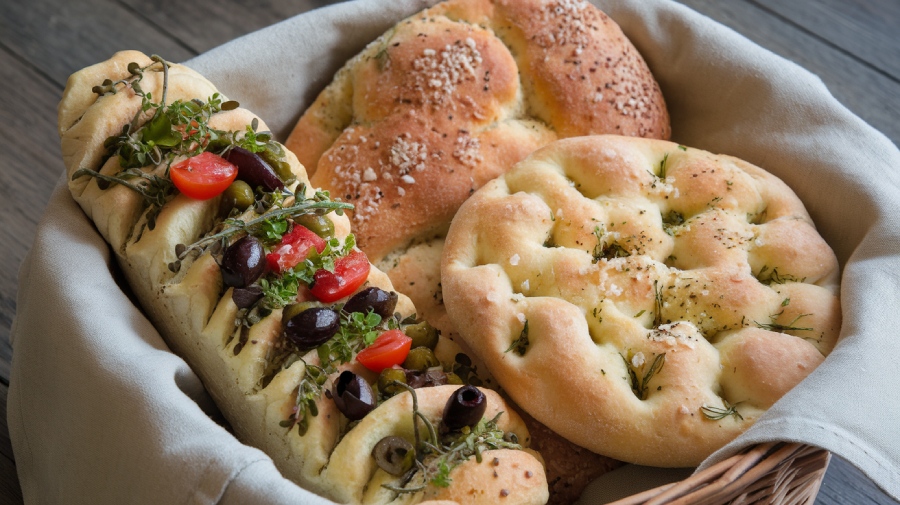
Focaccia’s versatility makes it an exciting canvas for your culinary creativity. With your overproofed sourdough focaccia, you can elevate your meals and snacks in delightful ways. Here are a few serving suggestions to inspire you:
- Savory Sandwich Base: Layer your focaccia with fresh vegetables, cheeses, and creamy spreads for a satisfying sandwich that packs a punch. Imagine biting into a sandwich filled with roasted peppers, arugula, and goat cheese—delicious!
- Unique Appetizer: Cut the focaccia into bite-sized pieces and serve them with dips like hummus, olive tapenade, or marinara. This makes for a fantastic appetizer at gatherings that guests will rave about.
- Mini Pizzas: Transform slices of focaccia into mini pizzas by adding tomato sauce, mozzarella, and your favorite toppings. Bake until the cheese is bubbly for a quick, tasty dish.
For breakfast, toast a slice and top it with creamy avocado and poached eggs, sprinkled with red pepper flakes for a morning treat that’s both satisfying and nutritious.
Frequently Asked Questions
What Can I Do With Overproofed Sourdough Bread?
If you’ve got overproofed sourdough bread, don’t toss it! You can transform it into delicious focaccia.
Just dimple the dough, add your favorite herbs and toppings, then bake it until golden. The result? A crispy exterior with a soft, airy interior.
You’re minimizing waste while enjoying a versatile dish that pairs perfectly with olive oil or spreads.
Get creative with flavors and enjoy your delicious culinary salvage!
How Do You Fix Overproofed Focaccia Dough?
If your focaccia dough seems a bit too enthusiastic, don’t worry! Gently deflate it to release some of that excess gas, restoring its structure.
Let it rest for about 30-60 minutes to regain elasticity. If it’s sticky, a light touch of olive oil on your hands will help.
Remember to create deep dimples before baking; they’ll lock in moisture and give you that delightful texture.
Bake at 425°F for a crispy finish!
Does Focaccia Need to Be Proofed?
Focaccia doesn’t need extensive proofing like traditional sourdough. Instead, it thrives on a shorter final rise after being shaped in the pan.
You’ll want to let it puff up until it’s jiggly, which usually takes about 1.5 to 2 hours. This quick rise helps create that delicious airy texture, especially once you dimple the dough.
Keep an eye on it to guarantee it doesn’t overproof, which can lead to a dense loaf.
What Can I Make With Sourdough That Didn’t Rise?
If your sourdough didn’t rise, don’t toss it out! You can turn that overproofed dough into a delicious focaccia.
Just dimple the dough, drizzle it with olive oil, and sprinkle some herbs or sea salt on top.
Generously oil your baking pan to guarantee a crispy crust. Bake it at 425°F for 25-30 minutes.
You’ll end up with a crispy exterior and a soft, fluffy interior that’s perfect for dipping or enjoying on its own!
Turn Overproofed Dough into a Baking Win
Incorporating overproofed sourdough into your focaccia can elevate your baking game. Did you know nearly 60% of home bakers struggle with proofing times?
By mastering this technique, you reduce waste and create a uniquely flavorful bread with airy pockets and a chewy crust. So, don’t shy away from that bubbly dough! Embrace it, and you’ll be rewarded with a delicious focaccia that’s perfect for sharing or savoring all on your own.

